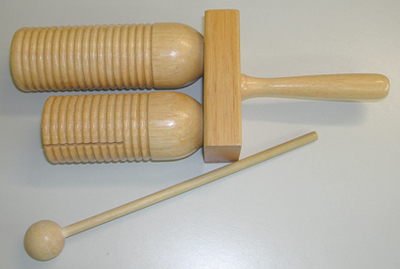| Approach: One
to one |
 |
304Kb |
|
 |
| Focus:
Interpretation
and representation of symbols to sounds |
| Resources: |
5
cards, agogo woodblock, beater, answer sheet |
| Kupu: |
poraka
köwakawaka = agogo woodblock, pao = beater, orotangi
= sound, whakawaiwai = practise |
|
|
Questions/instructions:
Hoatu
te poraka köwakawaka.
I tënei mahi, ka tito koe i tëtahi rerenga püoru hei whakatangi
mä te taputapu nei. Ko te poraka köwakawaka te ingoa o te taputapu.
Räwekehia
te taputapu i te tuatahi kia möhio ai koe ki öna orotangi katoa. Kia
kaha te whakarerekë i tö whakamahi i te pao.
Tukuna te äkonga ki te räwekeweke i te poraka köwakawaka.
Kia mutu, whakatakotoria te käri whakawaiwai ki mua i a ia.
|
Hand out
agogo woodblock.
In this activity you are going to make up a piece of music for this instrument
which is called an agogo woodblock. First, have a go at making as many different
sounds as you can. Try using the stick in different ways.
Allow time.
After student has experimented, place the practise card in front
of the student. |
1. Äta
whakaaro ki ngä momo orotangi e hängai ana ki ënei
tohu. Whakatangihia.
2. He aha i pënä ai tö whakatangi i ngä orotangi? He aha
te ähua o ngä tohu i whiriwhiri ai koe
i ënä orotangi? |
1.
Think about the sounds you could make with the agogo woodblock
to go with these symbols, then have a go at playing them.
2. Why did you make those sounds? What was it about the symbols that made you
choose those sounds? |
|
|
|
%
responses |
| Practise
card interpretation: |
(link
between symbols and sounds) strong |
27 |
| |
|
moderate
|
62 |
| |
|
weak
|
11 |
Whakatakotoria
ngä käri 1 ki te 4.
|
Set
out cards 1 to 4 in order. |
 |
 |
 |
 |
Kua
raupapa ënei käri, mai i te mea tuatahi ki te tuawhä.
He wä inäianei ki te whakaaro i ngä orotangi mö ia
käri. Whakamätauria te poraka köwakawaka. Tïmata
ki te käri tuatahi ka haere ki te tuarua, te tuatoru me
te tuawhä. Kia mutu te whakawaiwai, mäku koe e tono
ki te whakatangi mai i tö püoru.
Tukuna he wä mahi.
Nä, whakatangihia mai tö püoru. Tïmata ki
te käri tuatahi ka haere ki te tuarua, te tuatoru
me te tuawhä. |
I’ve
put these cards in order from card 1 to card 4. Take some time
to try out playing sounds for each row, starting with card 1
and carrying on to card 2, 3, then 4. After you have practised,
I’ll ask you to play your music.
Allow time.
Now play your music starting from card 1 then carrying on to card 2, 3, then
4. |
|
| Cards
1 – 4: |
|
|
%
responses |
| Interpretation: |
strong
and consistent for same symbols
on different cards |
25 |
| |
strong
on each card but not consistent |
22 |
| |
moderate
|
45 |
weak
(random) or no response |
8 |
| Inventiveness: |
strong (at
least 3–4 different sounds) |
49 |
| |
moderate
|
47 |
weak
|
4 |
Hoatu
te pepa me te pene.
Ko täu mahi inäianei, he tito i täu ake rerenga püoru. Tuhia
ki tënei pepa ngä tohu mö tö püoru. He wä hei whakamätau
i ëtahi raupapa orotangi rerekë, me te whakaaro anö me pëhea
te tuhi i ngä tohu ki te pepa. Kia reri mai koe, ka whakatangi mai i tö püoru
hei whakarongo mäku.
Tukuna he wä mahi.
Tënä, whakatangihia mai tö püoru hei whakarongo mäku.
Ka whakatangi te äkonga i tana püoru.
Hei whakamutunga, körero mai mö te ähua o ngä tohu, ä,
he aha i përä ai tö whakatangi i ia tohu. |
Hand
out paper and pencil.
Now you can compose your own piece of music. On this piece of paper I want you
to draw some symbols for your music. Take time to try some different combinations
and think about how you can draw them on the paper. When you are ready, you can
play your piece for me to listen to.
Allow time.
Now you can play your music for me to listen to.
Student plays music.
To finish off, I would like you to tell me about the symbols you made up, and
why you played them the way you did. |
|
| |
%
responses |
| OWN
COMPOSITION |
(symbols,
performance and explanation) |
|
Representation: |
(link
between symbols and sounds) |
strong
|
57 |
| |
moderate
|
31 |
weak
|
12 |
| Inventiveness:
|
|
strong
|
39 |
| |
moderate
|
55 |
weak
|
8 |
Effectiveness
as a musical
composition:
(consider
performance for sense of unity and
completion, appropriate range and repetition
of sounds, cohesiveness and confidence) |
|
| |
strong
|
22 |
moderate
|
70 |
weak
|
8 |
| Explanation/justification: |
strong
(using musical terms) |
5 |
| |
moderate
|
72 |
weak
|
23 |
Total
score: |
12–13
|
14 |
| |
10–11
|
26 |
8–9
|
23 |
6–7
|
23 |
4–5
|
7 |
0–3
|
7 |
Commentary:
About 40 percent of the students scored highly (total of 10 or more).
The weakest aspect was the explanation about the student’s composition.
|





